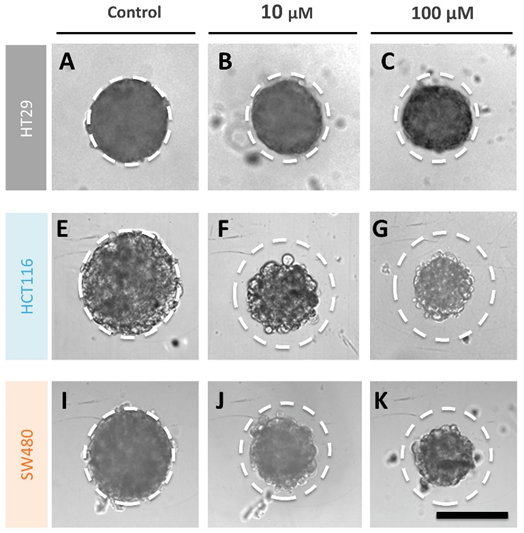
Quantifier la réponse à un anti-cancéreux
Angélique Carlotta, Sylvain Monnier, Thomas Dehoux, Hélène Delanoë-Ayari, Charlotte Rivière & Jean-Paul Rieu (équipe Biophysique), en collaboration avec des collègues de Lyon, ont publié un article intitulé "In-depth phenotypic characterization of multicellular tumor spheroids: effects of 5-fluorouracil" dans la revue PLOS One.
Quantifying the response to an anti-tumor treatment
Angélique Carlotta, Sylvain Monnier, Thomas Dehoux, Hélène Delanoë-Ayari, Charlotte Rivière & Jean-Paul Rieu (team Biophysics), with colleagues from Lyon, have published an article entitled "In-depth phenotypic characterization of multicellular tumor spheroids: effects of 5-fluorouracil" in the journal PLOS One.
Aucune méthode actuelle ne permet de prédire la résistance aux agents anticancéreux, base du développement métastatique et du faible taux de survie de nombreux cancers. Une avancée considérable serait de réaliser une analyse directe de l’effet d’anticancéreux sur des biopsies de patients. Pour se rapprocher de cet objectif, les auteurs ont développé une méthode permettant d’analyser le comportement des cellules dans des sphéroïdes multicellulaires 3D, mimant une tumeur. Ils ont notamment montré que la réponse à un des anticancéreux le plus utilisé en clinique pour le cancer du colon (le 5-fluorouracil) était très différente en fonction de l’état métastatique des cellules et qu’il avait un impact fort sur la cohésion de cette mini-tumeur. La méthodologie développée est transposable à plus grande échelle pour le criblage de médicaments afin de mieux anticiper la réponse au traitement.
There is currently no method for predicting resistance to antitumor treatments, causing metastatic development and low survival rates. A considerable advance would be to perform a direct analysis of the effect of anti-tumor treatments on patients biopsies. In line with this objective, the authors have developed a method to analyze the behavior of cells in 3D multicellular spheroids, mimicking a tumor. In particular, they showed that the response to one of the most commonly used anti-tumor drug for colon cancer (5-fluorouracil) was very different depending on the metastatic state of the cells and had a strong impact on the cohesion of these model tumors. This methodology could be applied for drugs screening to better anticipate the response to a chemotherapeutic treatment.
28/11/2017

Images typiques de sphéroides de cellules plus ou moins métastatiques (HT29, HCT116, SW480) obtenues en microscopie optique après 2 jours de traitement avec un anticancéreux (5-FU) à différentes concentrations. Les sphéroides diminuent en taille avec la concentration montrant l'effet de l'anticancéreux. Echelle = 200 µm.
Typical images of spheroids of more or less metastatic cells (HT29, HCT116, SW480) obtained by optical microscopy after 2 days of treatment with an anticancer drug (5-FU) at different concentrations. The spheroids decrease in size with the concentration, showing the effect of the drug. Scale Bar = 200 μm

















